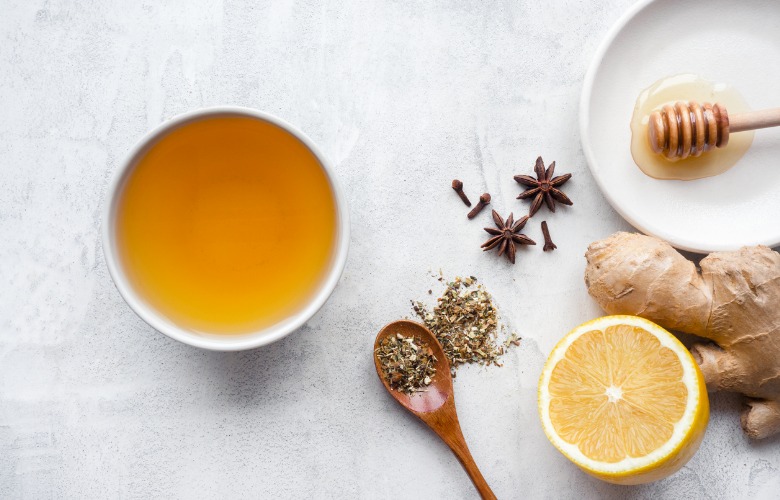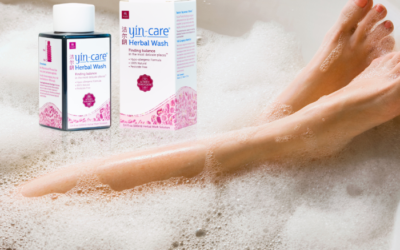Caught a Cold? Or down with the flu?
Starting before the beginning
Prevention starts with good habits. Wash your hands before eating. Don’t touch your mouth, nose or eyes unless your hands are clean. Gargle once or twice a day with warm salty water. Chinese medical theory says that illness enters the body on the wind through the Wind Gate. This located at the top of the upper back. Wear a scarf to keep this area protected and warm. Chinese herbs can help to address symptoms and prevent some.
If you get chilled, warm up physically and internally with a simple ginger, cinnamon and honey tea.
- 1-inch knob of fresh ginger sliced
- 1/2 teaspoon ground cinnamon
- Put in a mug add hot water.
- Steep for several minutes, add a teaspoon of honey and a
squeeze or two of a lemon, if you have one. - For a stronger and more warming concoction
simmer the first two ingredients in 1 1/2 cups of water for five to ten minutes.
Ginger and cinnamon are both key players in Chinese herbal medicine. Fresh Ginger or Sheng Jiang warms the body and releases cold that has been picked up. Cinnamon or Gui Zhi, do the same and helps to protect against an invasion of cold or flu.

Herbs at Home
The best time to treat a cold or flu is at the first appearance of symptoms, this is when Chinese herbal medicine can often keep you from getting sick. All is not lost if you do treat yourself and get sick anyway. Chinese herbs can shorten recovery and lessen the chance of secondary infections; such as sinusitis, bronchitis or extreme fatigue. Four formulas that belong in your at-home herbal medicine cabinet are Yin Qiao, Gan Mao Ling, Yin Chao Jr., and Chuan Xin Lian.
If it starts with a sore throat reach for Yin Qiao. Yin Qiao is named for the two main herbs in the formula; Jin Yin Hua is the honeysuckle flower and Lian Qiao is the fruit of the forsythia tree. Both these herbs are used for wind-heat invasion and have a special affinity for the throat and neck glands. This formula is best used at the first sign of a sore throat and for the first 24 hours thereafter.
If the illness continues to develop it’s time to switch formulas. Made of mostly cooling herbs for a heat invasion, Yin Qiao can be used for a cold invasion when the presenting symptom is a sore throat. A study on the H1N1 influenza virus shows good results for Yin Qiao usage (1). This formula is no one-trick pony. It was developed in China in 1798 for fever and rash conditions such as chickenpox and measles. The cooling and surface releasing herbs do literally cool and release the skin surface. As a result, Yin Qiao works well for Poison Oak and Poison Ivy rashes.
Usage: Take for 24 hours starting at the first signs of sore throat. Serving size is 4 count, three times day or as recommended by your health care practitioner. Reduce serving size if diarrhea or digestive upset occur.
Use Gan Mao Ling after Yin Qiao or if the nose is first to complain. Gan Mao Ling translates to “Common Cold Effective Remedy” and sometimes “Miraculous Cold Pills” Either way it is a classic for colds and flu of both the Wind-Cold and Wind-Heat varieties. The two top herbs in the formula paired together are strong antivirals (4). Gang Mei Gen, ilex asprelle or rough leafed holly, has been found to be effective against the flu virus (1). The other half of the pair San Cha Ku, evodia lepta, is commonly known as the Bee Bee Tree. Traditionally it has been used for intestinal complaints and for strengthening the nervous system. Studies show it decreases inflammation and shows promise as a therapy for Alzheimer’s (2) (3).
Usage: Gan Mao Ling is most effective when started in the early stages of invasion. Taken throughout the illness it will soften symptoms and speed recovery. The formula may be used for a few days to a few weeks. Gan Mao Ling can be used as a preventative.If you feel you have been exposed to a cold or flu or you are going to be around a crowd of people; serve it up. Serving size is 3-6 count three times a day. Use with caution in deficient or cold patients. Contraindicated if strong chills are present.

When a kid gets sick it’s time for Yin Chao Jr. As the name implies this is children’s formula. Liquid is easier for children to take. Adults who cannot, or will not, swallow pills can take this formula too. In Yin Chao Jr. the herbs unite to address the cold and flu symptoms (cough, sore throat, and headache) and the digestive complaints (low appetite, nausea, vomiting and constipation). A cranky, sick child is extra miserable, parents will rejoice to know there is an herb in this formula which helps relieve irritability.
Usage: Begin at first signs of illness. Serving size is 1 to 3 full droppers, every 3 to 4 hours, add to juice or to boiling water to partially evaporate the alcohol. Yin Chao Jr. is for children 8 months and older and for adults.
Feeling extra bad or been bitten by a zombie, Chuan Xin Lian to the rescue. Named for a single herb in the formula, Chuan Xin Lian is a trifecta of powerful herbal allies; Chuan Xin Lian, Pu Gong Ying and Ban Lan Gen. Chuan Xin Lian is traditionally used to cool strong heat disorders of the throat, lungs and skin. Pu Gong Ying is the fancy Chinese name for the humble dandelion. Mighty for clearing heat and infections, Pu Gong Ying has emerged as a cancer fighter as well (5).
Ban Lan Gen is the root of the woad plant. The leaf is used as a fabric dye and, file under interesting factoids, an ingredient in mummy wraps. The root of the woad has a strong broad-spectrum antimicrobial effect, especially with viruses. Bring this formula out for more severe symptoms of cold and flu; swollen glands, severe sore throat, yellow phlegm, cough, and fever. It is also used for UTIs and, in a pinch, can be crushed, dissolved in hot water and used topically for skin infections and snake bites.
Usage: Serving size is 3 count 3 times a day. Use with caution in Spleen deficient patients with a tendency to loose stools, diarrhea, poor appetite or chronic digestive weakness. Use herbs wisely.
If you have questions or special considerations, please work with your practitioner when stocking your herbal medicine cabinet. If symptoms worsen or you have concerns, contact a knowledgable practitioner. These statements have not been evaluated by the Food and Drug Administration. These products are not intended to diagnose, treat, cure or prevent any disease.
References
1 https://www.ncbi.nlm.nih.gov/pubmed/21844547
2 Gan Mei Gen – illes asprelle – flu virus – https://www.ncbi.nlm.nih.gov/pubmed/26957139
3 San Cha Ku – Evodia lepta – decreases inflammation – https://www.sciencedirect.com/science/article/pii/S0378874113003668
4 alzheimers promising for _ https://www.ncbi.nlm.nih.gov/pubmed/26434116
5 Dr.Jake Fratkin “Treating Viral Infections With Chinese Herbal Products”
6 https://www.mskcc.org/cancer-care/integrative-medicine/herbs/dandelion

A licensed acupuncturist since 1999, Diana lives and works in Santa Cruz, California. Her practice focuses on pain management, stress reduction, and creating health. A longtime friend of plants, she loves the herbal side of Traditional Chinese Medicine. Diana shares her herbal interests through writing and a card game she designed and illustrated: Herb Apocalypse*. Volunteer work includes The Rabbit Haven, a rabbit rescue, and Livity Rising, free community healing clinics. Author of Herb Apothecary: The Coloring Book: 54 Chinese Herbs available on Amazon.



